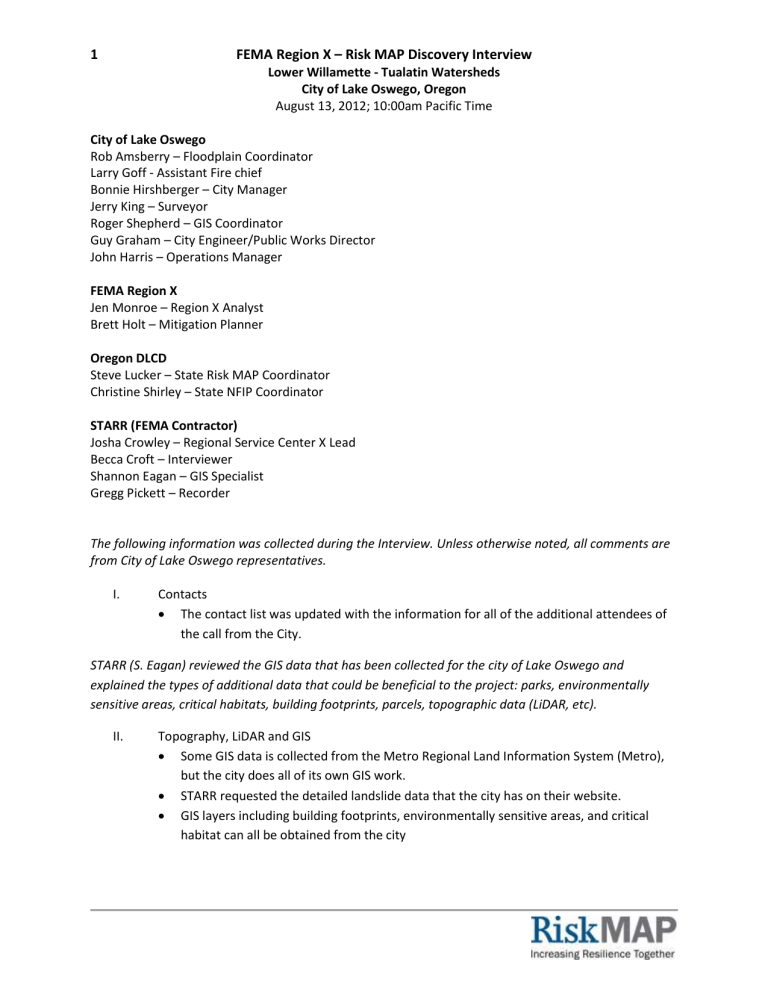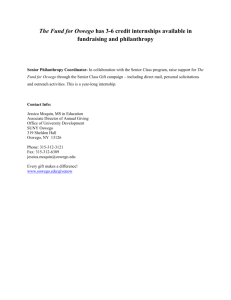FOR FEMA AND STATE REVIEW -MeetingMinutes

1 FEMA Region X – Risk MAP Discovery Interview
Lower Willamette - Tualatin Watersheds
City of Lake Oswego, Oregon
August 13, 2012; 10:00am Pacific Time
City of Lake Oswego
Rob Amsberry – Floodplain Coordinator
Larry Goff - Assistant Fire chief
Bonnie Hirshberger – City Manager
Jerry King – Surveyor
Roger Shepherd – GIS Coordinator
Guy Graham – City Engineer/Public Works Director
John Harris – Operations Manager
FEMA Region X
Jen Monroe – Region X Analyst
Brett Holt – Mitigation Planner
Oregon DLCD
Steve Lucker – State Risk MAP Coordinator
Christine Shirley – State NFIP Coordinator
STARR (FEMA Contractor)
Josha Crowley – Regional Service Center X Lead
Becca Croft – Interviewer
Shannon Eagan – GIS Specialist
Gregg Pickett – Recorder
The following information was collected during the Interview. Unless otherwise noted, all comments are from City of Lake Oswego representatives.
I.
Contacts
The contact list was updated with the information for all of the additional attendees of the call from the City.
STARR (S. Eagan) reviewed the GIS data that has been collected for the city of Lake Oswego and explained the types of additional data that could be beneficial to the project: parks, environmentally sensitive areas, critical habitats, building footprints, parcels, topographic data (LiDAR, etc).
II.
Topography, LiDAR and GIS
Some GIS data is collected from the Metro Regional Land Information System (Metro), but the city does all of its own GIS work.
STARR requested the detailed landslide data that the city has on their website.
GIS layers including building footprints, environmentally sensitive areas, and critical habitat can all be obtained from the city
Risk MAP Discovery Interview – Lower Willamette - Tualatin Watersheds
City of Lake Oswego – August 13, 2012
Page 2 of 4
III.
Planning
The City’s current Hazard Mitigation Plan (HMP) is being re-written and should be ready by October.
The City Planner is the best person to talk about the Comprehensive Plan, but he couldn’t make the call. The Comprehensive plan is the basis for all land use planning and growth management. This plan is scheduled to be updated in 2013.
No assistance from FEMA of the State is needed to wrap up either plan at the moment.
The city is trying to be consistent with the HMP plan for Clackamas County.
The Emergency Operations Plan was updated in 2010.
A LOMR resulting from new construction on the Lake Oswego Dam will lower the flood
elevation of lake.
Spring Brook Creek needs to be restudied. A LOMR was completed in mid-reach area of
Spring Brook Creek, but it doesn’t tie in well on either end of it. Those tie-in areas, as well as the entire portions of the creek upstream and downstream of the LOMR need to be restudied.
The City wanted to be sure that this project included Clackamas County, and the Cities of West Linn and Gladstone. This is because Lake Oswego’s water treatment facility is located in West Linn, while the water intake is in Gladstone.
Lake Oswego did not have a contact person for the City of Gladstone.
The City considers 15 local reservoirs, bridges, and an inlet structure on the Tualatin
River to be critical facilities. Also the police station, all fire department stations, City
Hall, retail stores, the downtown corridor, and the Public Works Operations Center are considered critical facilities.
IV.
Earthquakes
No historic earthquakes have occurred, but there is a lot of slope within the city with poor soil types. Some limited retrofitting of buildings has taken place. Some key
V.
facilities are located in high hazard areas.
Wildfires
There are some steep slopes and dry brush that could have wildfire potential. Multimillion dollar homes could be affected by a wildfire in the city. Some outreach has been done for this. Fires are not an annual problem, but an occasional one. There is usually enough rain each year to keep the fire hazard down.
The city has 600 acres of parks. Some fuel mitigation is occasionally done, especially around structures. Lake Oswego is currently pursuing potential mitigation grants for fire hazard reduction.
VI.
Landslides
Several potential landslide areas are scattered around the city. Several areas with historic landslides have affected both transportation lines and residential areas.
The State is working on landslide hazard maps within the city. These are scheduled to be completed in the next year.
Risk MAP Discovery Interview – Lower Willamette - Tualatin Watersheds
City of Lake Oswego – August 13, 2012
Page 3 of 4
VII.
Severe Storms
High winds, freezing rain, and severe storms occur each year in the city.
Downed trees and power lines are the main problems for the city after a severe storm.
Potential shelters have been identified, and the City works with the Red Cross for any needs resulting from severe storms.
The best tool to notify the public is Code Red, which is similar to Reverse 911.
Media is also used to transmit information to the public in the event of an emergency
(local media, direct email, the city website, the city hotline, etc…)
Television is the primary means for the public to receive information. Local television stations do a good job, as do the local newspapers.
With Downtown Portland being only 10 miles away, the city is covered well by the
Portland media outlets.
The city gets weather information from the National Weather Service for significant weather events. NWS gives webinar briefings before any major events occur here.
Social media is also used to some degree. A lot more people are covered using
Facebook and Twitter than by the city’s email system.
Cell phones can also be registered to receive warnings through Code Red (for a specific area of the city). The Code Red System makes 1000 phone calls per minute. Code Red controls the database, but the city supplies the data to Code Red.
VIII.
Flooding
The Washington County Flood Insurance Rate Maps are being updated, but have not gone effective yet.
Other than the Spring Brook Creek area, most problem areas on the FIRMs within the city will be resolved when the new Washington County maps become effective.
There are no known areas or structures in the city with repetitive damage.
The outlet from Lake Oswego has never been accurately accessed (with flood elevations). More detailed information in this area would be helpful to the City. A new spillway has been built and so flooding potential in this area has been changed.
IX.
Backwater from Willamette River may also affect this area.
Spring Brook Creek where it enters Lake Oswego is a problem area for the city.
Small localized flooding occurs in the City, especially along the smaller stream corridors.
Drainage in un-curbed areas can be an occasional problem, with water ending up on some properties, causing some minor damage. Some capital improvement projects are currently being planned, with funding possibly through mitigation grants.
On August 24, 2012, a new LOMR will go into effect, with approximately 300 homes being removed from the effective flood zone. This LOMR is the result of re-construction on the Lake Oswego Dam.
Levees
There are no levees within the city of Lake Oswego.
Risk MAP Discovery Interview – Lower Willamette - Tualatin Watersheds
City of Lake Oswego – August 13, 2012
Page 4 of 4
X.
XI.
Environmentally Sensitive Areas
There are environmentally sensitive lands throughout the city. These areas include Iron
Mountain, Triumph Creek, Spring Brook Creek, and some wetlands.
The city has 600 acres of parks and open space.
A project underway between Highway 43 and the Willamette River in a formerly industrial area. Much of this area is in the current (and future) floodplain and there is potential need for a flood study in this area, or perhaps ways that it can be made more flood resistant. This project is considered a redevelopment area. One possible solution that has been talked about is a levee in this area. Fill has also been considered as a potential way to raise this area up out of the floodplain.
Communications and Outreach
Every November a mailer goes out to every resident and business regarding winter preparedness, with other newsletters sent occasionally throughout the year with earthquake and other disaster preparedness materials included in it.
Safety fairs occur, given by the local fire departments, Red Cross, and Public Works.
Presentations regarding emergencies and preparedness are given to local organizations and neighborhood associations.
A full-scale emergency exercise occurs once per year.
The City has had success by sending out reminders about the Code Red system. Each time this occurs, additional people have been signing up for the program.
The Red Cross is the only outside agency that the City works with for emergencies and disasters.
The City does not currently participate in the Community Rating System, but said that it is a topic worth revisiting.
The City was open to more training and tools, supplied by FEMA and the State.
No regular meetings occur in the city.
The current floodplain administrator is Rob Amsberry.
The City relies on planning review and the permit process to regulate building in floodplains.
C. Shirley gave background on how permitting and the CRS program can be integrated.
The City referred to this issue as a “potential hot potato”.
XII.
Other
The City was very open to a future call, if it is deemed necessary.
The City will send the new Hazard Mitigation Plan to FEMA, the State, and STARR when it is completed in a few months.
C. Shirley informed the City that they may want to identify and map pre-FIRM structures in the Hazard Mitigation Plan, since flood insurance premiums will be going up dramatically over the next 5 years, and this could potentially reduce their rates.








